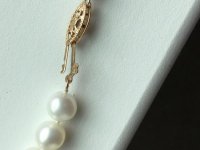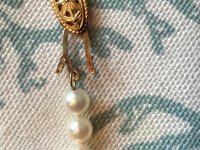You are using an out of date browser. It may not display this or other websites correctly.
You should upgrade or use an alternative browser.
You should upgrade or use an alternative browser.
Mom left me these. Need help please
- Thread starter Moomoo
- Start date
Pearl Dreams
Pearl Enthusiast
Hi Moomoo, welcome to Pearl Guide.
How nice to inherit pearls! Whatever they are, they are a sentimental gift that can be enjoyed.
We need some more photos. Can you curl the necklace in a spiral and take a photo against a white paper towel or other white background, so we can see the whole strand? Take close ups of any blemishes you see, too.
I was trying to read the stamp on the clasp. Not sure if it's 925 (vermeil, gold plated over silver) or 585 (14K gold.) Can you see it with a magnifier?
Rub two of the pearls near the clasp together gently. Does it feel gritty, or do they glide smoothly? Gritty = real nacre (so either freshwater pearls or akoyas) while gliding smoothly = imitation. (Usually. There are exceptions. A polished real pearl may feel smooth and a grimy imitation pearl may not glide smoothly.)
If you happen to have a jeweler's loupe (a 10x magnifier) look at the surface of the pearls. At that magnification, real pearl nacre looks very smooth, while imitation pearl coating has a coarser looking texture.
Look at the drill holes. Are there any swirls of excess coating, or are the holes large, or beveled? If so, they are imitations. (But high end imitations would have small, straight (non-beveled) drill holes like real pearls with no excess swirls of coating, so the lack of these is not a guarantee of genuine pearls.)
Are there any areas where the coating is missing? Imitation pearls have thin flaky coating that reveals the glass bead if it peels off.
How nice to inherit pearls! Whatever they are, they are a sentimental gift that can be enjoyed.
We need some more photos. Can you curl the necklace in a spiral and take a photo against a white paper towel or other white background, so we can see the whole strand? Take close ups of any blemishes you see, too.
I was trying to read the stamp on the clasp. Not sure if it's 925 (vermeil, gold plated over silver) or 585 (14K gold.) Can you see it with a magnifier?
Rub two of the pearls near the clasp together gently. Does it feel gritty, or do they glide smoothly? Gritty = real nacre (so either freshwater pearls or akoyas) while gliding smoothly = imitation. (Usually. There are exceptions. A polished real pearl may feel smooth and a grimy imitation pearl may not glide smoothly.)
If you happen to have a jeweler's loupe (a 10x magnifier) look at the surface of the pearls. At that magnification, real pearl nacre looks very smooth, while imitation pearl coating has a coarser looking texture.
Look at the drill holes. Are there any swirls of excess coating, or are the holes large, or beveled? If so, they are imitations. (But high end imitations would have small, straight (non-beveled) drill holes like real pearls with no excess swirls of coating, so the lack of these is not a guarantee of genuine pearls.)
Are there any areas where the coating is missing? Imitation pearls have thin flaky coating that reveals the glass bead if it peels off.
Elana56
New Member
Just want to make an addition to this great information above. Find a jeweler who has the graduate gemologist degree from GIA (Graduate Institute of America) and they will be able to quickly ID the metal and the pearls.
Moomoo
New Member
Hi Moomoo, welcome to Pearl Guide.
How nice to inherit pearls! Whatever they are, they are a sentimental gift that can be enjoyed.
We need some more photos. Can you curl the necklace in a spiral and take a photo against a white paper towel or other white background, so we can see the whole strand? Take close ups of any blemishes you see, too.
I was trying to read the stamp on the clasp. Not sure if it's 925 (vermeil, gold plated over silver) or 585 (14K gold.) Can you see it with a magnifier?
Rub two of the pearls near the clasp together gently. Does it feel gritty, or do they glide smoothly? Gritty = real nacre (so either freshwater pearls or akoyas) while gliding smoothly = imitation. (Usually. There are exceptions. A polished real pearl may feel smooth and a grimy imitation pearl may not glide smoothly.)
If you happen to have a jeweler's loupe (a 10x magnifier) look at the surface of the pearls. At that magnification, real pearl nacre looks very smooth, while imitation pearl coating has a coarser looking texture.
Look at the drill holes. Are there any swirls of excess coating, or are the holes large, or beveled? If so, they are imitations. (But high end imitations would have small, straight (non-beveled) drill holes like real pearls with no excess swirls of coating, so the lack of these is not a guarantee of genuine pearls.)
Are there any areas where the coating is missing? Imitation pearls have thin flaky coating that reveals the glass bead if it peels off.
I will be back home Tuesday. There are 3 different strands. I will do as you asked for all three. One is a 585 with a b and a box. I’ll try and take better pics also. Thanks for replying
Moomoo
New Member
Thanks! I will surely do that but I didnt want to waste anyone’s time.
Pearl Dreams
Pearl Enthusiast
Moomoo, that's what this forum is for--- it's not a waste of time! We have this section so people can discover what kind of pearls they have.  You can go to a jeweler, but I have found that few jewelers know pearls. (Around here, at least.)
You can go to a jeweler, but I have found that few jewelers know pearls. (Around here, at least.)
I'll add a little more information that may help you figure out what they are.
Assuming the pearls pass the "tooth test" (i.e. rubbing the pearls together or against the edge of a front tooth to see if they are gritty) the question would then be if they are freshwaters or akoyas. Edited to add: I have stopped recommending rubbing pearls against teeth (“Tooth test”) Teeth are harder than pearls and can scratch them. Rub 2 of the pearls together instead.
Freshwaters that size don't have a bead inside to make them fully round, so if they are a bit egg shaped, they are freshwaters.
If they pass the tooth test and are 100% round, then they're akoyas.
I look forward to your photos!
I'll add a little more information that may help you figure out what they are.
Assuming the pearls pass the "tooth test" (i.e. rubbing the pearls together or against the edge of a front tooth to see if they are gritty) the question would then be if they are freshwaters or akoyas. Edited to add: I have stopped recommending rubbing pearls against teeth (“Tooth test”) Teeth are harder than pearls and can scratch them. Rub 2 of the pearls together instead.
Freshwaters that size don't have a bead inside to make them fully round, so if they are a bit egg shaped, they are freshwaters.
If they pass the tooth test and are 100% round, then they're akoyas.
I look forward to your photos!
Last edited:
CathyKeshi
Well-known member
Moomoo, don't worry about wasting our time ... we love looking at pearls! Look forward to seeing more photos of your treasures; I'm sure they have sentimental value for you no matter what type 
Moomoo
New Member
I took some pics hope this helps
I took some pics hope this helps
Took some photos. The yellowish ones I can’t get a grit on my teeth. They were my great grandmas. I have no idea how old they are, my mom just passed this past Christmas and she was 82
I took some pics hope this helps
Moomoo, that's what this forum is for--- it's not a waste of time! We have this section so people can discover what kind of pearls they have.You can go to a jeweler, but I have found that few jewelers know pearls. (Around here, at least.)
I'll add a little more information that may help you figure out what they are.
Assuming the pearls pass the "tooth test" (i.e. rubbing the pearls together or against the edge of a front tooth to see if they are gritty) the question would then be if they are freshwaters or akoyas.
Freshwaters that size don't have a bead inside to make them fully round, so if they are a bit egg shaped, they are freshwaters.
If they pass the tooth test and are 100% round, then they're akoyas. The last pic is after I realized how dirty the clasp pic was of the yellow ones so I cleaned it a bit.
I look forward to your photos!
Took some photos. The yellowish ones I can’t get a grit on my teeth. They were my great grandmas. I have no idea how old they are, my mom just passed this past Christmas and she was 82
Attachments
-
 EE651294-34F1-4296-959B-F2F659808E2D.jpg50 KB · Views: 145
EE651294-34F1-4296-959B-F2F659808E2D.jpg50 KB · Views: 145 -
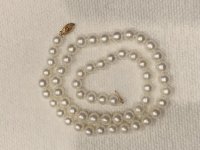 16782EBD-FA26-4BA2-A2CC-B1109CDCD216.jpg73.4 KB · Views: 136
16782EBD-FA26-4BA2-A2CC-B1109CDCD216.jpg73.4 KB · Views: 136 -
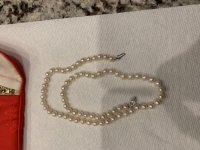 BDBFA9F4-8E64-411E-9CCF-43E68167C9DA.jpg92.8 KB · Views: 137
BDBFA9F4-8E64-411E-9CCF-43E68167C9DA.jpg92.8 KB · Views: 137 -
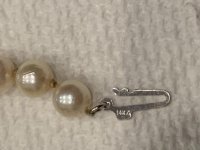 FAD385D4-777F-4751-AAC3-08865C50B7F3.jpg61.5 KB · Views: 118
FAD385D4-777F-4751-AAC3-08865C50B7F3.jpg61.5 KB · Views: 118 -
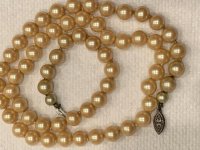 2BB5F222-A54E-4858-90FE-9C03DF327370.jpg86 KB · Views: 120
2BB5F222-A54E-4858-90FE-9C03DF327370.jpg86 KB · Views: 120 -
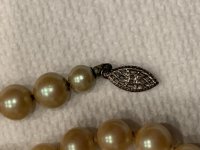 EB643C24-9A26-426D-A025-234D0E00A79C.jpg67.8 KB · Views: 125
EB643C24-9A26-426D-A025-234D0E00A79C.jpg67.8 KB · Views: 125 -
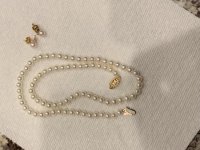 A02F8AAB-2FCA-4CE3-9B18-B89A40FB9F3A.jpg88.3 KB · Views: 117
A02F8AAB-2FCA-4CE3-9B18-B89A40FB9F3A.jpg88.3 KB · Views: 117 -
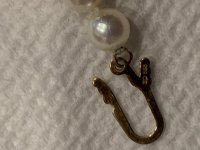 D0050FFD-F60E-40BA-A784-AE0F18957154.jpg71.4 KB · Views: 136
D0050FFD-F60E-40BA-A784-AE0F18957154.jpg71.4 KB · Views: 136 -
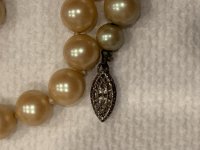 95100087-8098-4627-96E4-7F0FC3056960.jpg80 KB · Views: 135
95100087-8098-4627-96E4-7F0FC3056960.jpg80 KB · Views: 135
Pearl Dreams
Pearl Enthusiast
I'm sorry for your loss!
I see 4 strands in these last photos.
1. photos 1 & 2, creamy white pearls with 14K white gold clasp-- these are cultured akoya pearls. It would not be a high end strand with those surface characteristics, but they are real.
2. photos 3&4, white pearls. The yellow clasp seems to read 14K. Have these been restrung? The way they are finished at the clasp (with the thread connecting directly with the clasp instead of having a coil of gimp / French wire there to protect the thread) is not the way good strands are typically finished. The pearls graduate a little toward the center. They look just a little off-round to me, too. I think they are cultured freshwater pearls. They would be solid nacre (no bead inside) and very durable, suited to everyday wear.
3. photos 5, 6 & 9-- these are the yellow colored pearls that you said don't feel gritty. The way they have a single, smaller pearl near the clasp is something I often see with fake pearl necklaces. The tarnished clasp is probably silver-- see if you can see a 925 or the word Sterling stamped on it. If so and if you decide to dispose of this strand, you might want to save the clasp to polish up and reuse.
Edited to add-- you may feel sentimental about these even if fake, and want to wear them. If so, give them a good bath in warm soapy water (not detergent) and restring them.
4. photos 7&8 white pearls with 585 (yellow gold) clasp. Like the first stand, cultured akoya pearls with similar surface blemishes. These seem whiter and have a brigher luster than the first akoya strand.
You may wish to restring this necklace. The bare thread at the clasp looks dirty and worn. Silk gets weak when it's old, wet, or dirty, and if it breaks you risk losing the necklace. A number of us restring our own pearls-- it isn't hard and the materials are inexpensive. See instruction tutorials and videos in the Lowly Beaders Club here on Pearl Guide.
For that matter, you may wish to restring all 3 of the real pearl necklaces. Pearls look better with fresh clean thread. Give them a bath first and wipe away grime with a soft cloth.
Give them a bath first and wipe away grime with a soft cloth.
I see 4 strands in these last photos.
1. photos 1 & 2, creamy white pearls with 14K white gold clasp-- these are cultured akoya pearls. It would not be a high end strand with those surface characteristics, but they are real.
2. photos 3&4, white pearls. The yellow clasp seems to read 14K. Have these been restrung? The way they are finished at the clasp (with the thread connecting directly with the clasp instead of having a coil of gimp / French wire there to protect the thread) is not the way good strands are typically finished. The pearls graduate a little toward the center. They look just a little off-round to me, too. I think they are cultured freshwater pearls. They would be solid nacre (no bead inside) and very durable, suited to everyday wear.
3. photos 5, 6 & 9-- these are the yellow colored pearls that you said don't feel gritty. The way they have a single, smaller pearl near the clasp is something I often see with fake pearl necklaces. The tarnished clasp is probably silver-- see if you can see a 925 or the word Sterling stamped on it. If so and if you decide to dispose of this strand, you might want to save the clasp to polish up and reuse.
Edited to add-- you may feel sentimental about these even if fake, and want to wear them. If so, give them a good bath in warm soapy water (not detergent) and restring them.
4. photos 7&8 white pearls with 585 (yellow gold) clasp. Like the first stand, cultured akoya pearls with similar surface blemishes. These seem whiter and have a brigher luster than the first akoya strand.
You may wish to restring this necklace. The bare thread at the clasp looks dirty and worn. Silk gets weak when it's old, wet, or dirty, and if it breaks you risk losing the necklace. A number of us restring our own pearls-- it isn't hard and the materials are inexpensive. See instruction tutorials and videos in the Lowly Beaders Club here on Pearl Guide.
For that matter, you may wish to restring all 3 of the real pearl necklaces. Pearls look better with fresh clean thread.
Last edited:
BWeaves
Well-known member
The yellow pearls are imitations. I have similar pearls from my grandmother and her "good" fakes have yellowed over the decades, but I keep them for sentimental reasons. The white pearls are real akoyas. Not the highest quality due to surface imperfections, but quite beautiful. Definitely get them washed and restrung and wear them. I actually prefer the surface imperfections because it lets me know they are real pearls.
Moomoo
New Member
Thanks to everyone!
Thanks to everyone!
There are 4 strands. I will give some away and restring a strand for myself. They’re worth more sentimentally than money. Thanks!
Thanks to everyone!
I'm sorry for your loss!
I see 4 strands in these last photos.
1. photos 1 & 2, creamy white pearls with 14K white gold clasp-- these are cultured akoya pearls. It would not be a high end strand with those surface characteristics, but they are real.
2. photos 3&4, white pearls. The yellow clasp seems to read 14K. Have these been restrung? The way they are finished at the clasp (with the thread connecting directly with the clasp instead of having a coil of gimp / French wire there to protect the thread) is not the way good strands are typically finished. The pearls graduate a little toward the center. They look just a little off-round to me, too. I think they are cultured freshwater pearls. They would be solid nacre (no bead inside) and very durable, suited to everyday wear.
3. photos 5, 6 & 9-- these are the yellow colored pearls that you said don't feel gritty. The way they have a single, smaller pearl near the clasp is something I often see with fake pearl necklaces. The tarnished clasp is probably silver-- see if you can see a 925 or the word Sterling stamped on it. If so and if you decide to dispose of this strand, you might want to save the clasp to polish up and reuse.
Edited to add-- you may feel sentimental about these even if fake, and want to wear them. If so, give them a good bath in warm soapy water (not detergent) and restring them.
4. photos 7&8 white pearls with 585 (yellow gold) clasp. Like the first stand, cultured akoya pearls with similar surface blemishes. These seem whiter and have a brigher luster than the first akoya strand.
You may wish to restring this necklace. The bare thread at the clasp looks dirty and worn. Silk gets weak when it's old, wet, or dirty, and if it breaks you risk losing the necklace. A number of us restring our own pearls-- it isn't hard and the materials are inexpensive. See instruction tutorials and videos in the Lowly Beaders Club here on Pearl Guide.
For that matter, you may wish to restring all 3 of the real pearl necklaces. Pearls look better with fresh clean thread.Give them a bath first and wipe away grime with a soft cloth.
There are 4 strands. I will give some away and restring a strand for myself. They’re worth more sentimentally than money. Thanks!
Moomoo
New Member
Thanks to all! I will keep one for myself and have it restrung and give the rest to nieces. Hopefully they will appreciate them. They’re worth more to me since they were my Moms. Appreciate the help!
Similar threads
- Replies
- 10
- Views
- 786
- Replies
- 8
- Views
- 523

